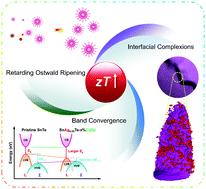当前位置:
X-MOL 学术
›
Energy Environ. Sci.
›
论文详情
Our official English website, www.x-mol.net, welcomes your
feedback! (Note: you will need to create a separate account there.)
Retarding Ostwald ripening through Gibbs adsorption and interfacial complexions leads to high-performance SnTe thermoelectrics
Energy & Environmental Science ( IF 32.4 ) Pub Date : 2021-09-03 , DOI: 10.1039/d1ee01977e Decheng An 1 , Jiangjing Wang 2, 3 , Jie Zhang 1 , Xin Zhai 1 , Zepeng Kang 4 , Wenhao Fan 4 , Jian Yan 5 , Yequn Liu 6 , Lu Lu 7 , Chun-Lin Jia 7 , Matthias Wuttig 2 , Oana Cojocaru-Mirédin 2 , Shaoping Chen 1 , Wenxian Wang 1 , G. Jeffrey Snyder 8 , Yuan Yu 2
Energy & Environmental Science ( IF 32.4 ) Pub Date : 2021-09-03 , DOI: 10.1039/d1ee01977e Decheng An 1 , Jiangjing Wang 2, 3 , Jie Zhang 1 , Xin Zhai 1 , Zepeng Kang 4 , Wenhao Fan 4 , Jian Yan 5 , Yequn Liu 6 , Lu Lu 7 , Chun-Lin Jia 7 , Matthias Wuttig 2 , Oana Cojocaru-Mirédin 2 , Shaoping Chen 1 , Wenxian Wang 1 , G. Jeffrey Snyder 8 , Yuan Yu 2
Affiliation

|
Nanoprecipitation is a routine method to decrease the thermal conductivity for advancing thermoelectric performance. However, the coarsening/Ostwald ripening of precipitates under temperature gradients in long-duration service deteriorates the efficacy of this strategy. Enlightened by the Gibbs adsorption-induced suppression of Ostwald ripening, we designed a highly stable thermoelectric system SnAg0.05Te-x%CdSe with embedded novel core/shell nanoprecipitates. Scanning transmission electron microscopy and atom probe tomography reveal that the precipitate core is CdTe and the shell is formed by Ag segregation with structures and compositions different from its abutting phases, termed interfacial complexions. This complexions layer suppresses the coarsening of precipitates by decreasing the interfacial Gibbs free energy, resulting in a high number of nanoscale precipitates. The enlarged phonon scattering cross-section of nanoprecipitates enabled by Gibbs adsorption along with interfacial complexions restrains the lattice thermal conductivity to its minimum while maintaining high carrier mobility. This eventually leads to an outstanding figure-of-merit (zT) of 1.5 at 873 K in thermally aged SnAg0.05Te-6%CdSe, assisted with valence band flattening and convergence. This work explores the mechanisms underpinning precipitate stabilization and provides a new paradigm to design nanostructured thermoelectrics.
中文翻译:

通过吉布斯吸附和界面络合延缓奥斯特瓦尔德熟化导致高性能 SnTe 热电材料
纳米沉淀是降低热导率以提高热电性能的常规方法。然而,在长期使用中,在温度梯度下沉淀物的粗化/奥斯特瓦尔德熟化会降低该策略的效果。受吉布斯吸附诱导抑制奥斯特瓦尔德熟化的启发,我们设计了一种高度稳定的热电系统 SnAg 0.05 Te- x带有嵌入的新型核/壳纳米沉淀物的 %CdSe。扫描透射电子显微镜和原子探针断层扫描显示,沉淀核是 CdTe,壳是由 Ag 偏析形成的,其结构和成分与其邻接相不同,称为界面复合物。该络合物层通过降低界面吉布斯自由能来抑制沉淀物的粗化,从而产生大量纳米级沉淀物。通过吉布斯吸附和界面络合使纳米沉淀物的声子散射截面扩大,将晶格热导率限制到最低,同时保持高载流子迁移率。这最终导致在 873 K 的热老化 SnAg 0.05 中具有 1.5的优异品质因数 ( zT )Te-6%CdSe,协助价带平坦化和收敛。这项工作探索了支持沉淀稳定的机制,并为设计纳米结构热电提供了新的范例。
更新日期:2021-09-09
中文翻译:

通过吉布斯吸附和界面络合延缓奥斯特瓦尔德熟化导致高性能 SnTe 热电材料
纳米沉淀是降低热导率以提高热电性能的常规方法。然而,在长期使用中,在温度梯度下沉淀物的粗化/奥斯特瓦尔德熟化会降低该策略的效果。受吉布斯吸附诱导抑制奥斯特瓦尔德熟化的启发,我们设计了一种高度稳定的热电系统 SnAg 0.05 Te- x带有嵌入的新型核/壳纳米沉淀物的 %CdSe。扫描透射电子显微镜和原子探针断层扫描显示,沉淀核是 CdTe,壳是由 Ag 偏析形成的,其结构和成分与其邻接相不同,称为界面复合物。该络合物层通过降低界面吉布斯自由能来抑制沉淀物的粗化,从而产生大量纳米级沉淀物。通过吉布斯吸附和界面络合使纳米沉淀物的声子散射截面扩大,将晶格热导率限制到最低,同时保持高载流子迁移率。这最终导致在 873 K 的热老化 SnAg 0.05 中具有 1.5的优异品质因数 ( zT )Te-6%CdSe,协助价带平坦化和收敛。这项工作探索了支持沉淀稳定的机制,并为设计纳米结构热电提供了新的范例。











































 京公网安备 11010802027423号
京公网安备 11010802027423号